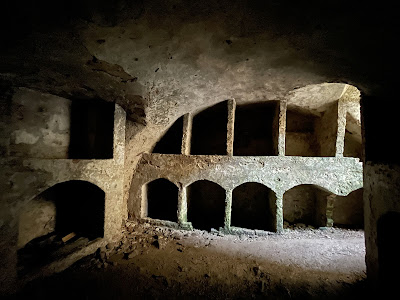Ladybower Reservoir is the largest of three reservoirs of the Upper Derwent Valley in the Peak District (the other two are Derwent Reservoir & Howden Reservoir). They have a combined capacity of 464 billion litres of water.
But what was there before the water?
 |
| Ladybower Reservoir |
Ladybower was built between 1935 and 1943, but 2 small villages - Derwent & Ashopton were flooded in the process. It took another 2 years to fill. At the time it was the largest reservoir in Britain.
 |
| Photo from 'Exploring GB' |
The River Derwent flowed through Derwent Village under stone bridges and next to it stood cottages, houses and a school. The village church of St John & St James had been built in 1757.
 |
| The church spire of the village of Derwent, which was flooded in 1943 |
Most of the Derwent church was pulled down but the spire was left as a memorial & could be seen when the water level was low. Unfortunately the spire was demolished.in 1947.
 |
| (Taken from a 1960s BBC film about Ladybower Reservoir) |
 |
| Derwent Hall |
 |
| An intriguing part of the Hall's structure perhaps it was part of the garden terrace. It's hard to say |
Despite fierce local opposition, the buildings in both villages were compulsory purchased by the Derwent Valley Water Board between 1935 and 1945. The people living there were forced to move to the nearby village of Bamford.
The bodies of their relatives were exhumed from the churchyard and the buildings demolished.
The church of St John & St James in Derwent held its final service on 17th March 1943. The final service at the Wesleyan Methodist Chapel in Ashopton was on 25th September 1939, with the last hymn reportedly being ‘The Day’s Dying in the West’. The chapel was demolished in 1943.
Not all Derwent’s buildings were sacrificed for the construction of the reservoir. A few of the houses remain.
A 17th century packhorse bridge that once crossed the River Derwent close to the Hall was saved. When the Derwent Hall was demolished, it was removed stone by stone & rebuilt at the head of Howden Reservoir in 1959.
 |
| Construction of the Ashopton Viaduct, it opened in 1943 |
 |
| Ashopton village in the shadow of the Viaduct |
 |
| Ladybower Reservoir |
Source: Rural Historia and Exploring GB
And what about the construction of the reservoirs and the dam workers in their Tin Town - that is another story...





























